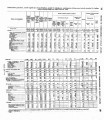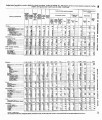| OCR Text |
Show REPORT OF CO~ISSIONER OF INDIAN AFFAIRS 19 under restriction in this vicinity, whjch possibly may be leased and developed into available oil-producing lands. Within the Ute Reservation, N. Mex., there are several good gas wells which have been closed because there was no market for gas, but negotiations are now in progress with the Mesa Grande Gas Co. for construction of a p- ip- e line in order to market the gas in the city of Durango, Colo. - Five oil wells within the Crow Reservation, Mont:, and a number of wells within ceded lands of the Shoshone Reservation, Wyo., remain closed. The oil from these fields is heavy in its crude state and of low gravity, and there are no pipe lines to the fields which afford the necessary outlet to a market. Production from the Osage Reservation, Okla., during the year amounted to 16,629,116 barrels of oil, from which, including certain deferred bonus payments, an income of $7,441,940 was derived. There has been a noticeable lessening of productlo? and receipts from Osage oil and gas leases for several years and it appears that the high point has been reached and that these leases are now on the decline. Two public-auction sales of oil leasea were held at Osage during the year, at which leases on 47,434 acres were so!d. A provl-sion was inserted in the leases, enabling the Secretary m his discre-tion to impose restrictions upon oil production when deemed neces-sary as a conservation measure and + conformance wth s~rmlar restrictions im~osed uDon other wells ln Oklahoma bv State au-thority or agreement 6 t h operators. A provision in the act approved March 2, 1929 (45 Stat. L. 1478), extends the trust period on the Osage lands, moneys, and other restricted properties until January 1, 1959. This act also.amends the act of March 3, 1921, so as to give the Secretaq more &scret!on in determining the acreage of Osage lands to be offered for leasY annuallv and orovides that not less than 25.000 acres shall be offere for oil and g& mining purposes during any one year. Under the act of March 3. 1921. it was necessaw to offer ao-~ roximatel1~0 0,000 acres each year. ' There was an increase in production from restricted lands of members of the Five Civilized Tribes, Oklahoma, over the production of the prior year, the total for the ear being 27,698,850 barrels. The total income fromleases of the lan~ s7 of these tribes was $5,636,919. QUAPAW LEAD AND ZINC MINING LANDS The lands of the Quapaw Reservation, Okla., are rich in deposits of lead and zinc. The lands lie in what is known as the Tri-State lead and zinc mining district. M i wa s first conducted within the reservation in 1902, and since 1917 the production of zinc-lead ore has increased enormously. During the year the mines of these Indians under departmental supervision produced 24 per cent of the lead and 32 per cent of the zinc output from the Tri-State district, and about 3.9 per cent of the lead and 14.2 per cent of the zmc output from ore mined in the United Stqtes. At the close of the fiscal year, there were 50 departmental lead and zinc mining !ease$ in force, embracing 6,284 acres; and 44 subleases in force, oovenng 2,294 acres. From these leases 186,423 tons of lead and zinc concentrates were sold during the year for $8,809,442 and the royalties received there-from for the Indians amounted to $848,219. |

















































